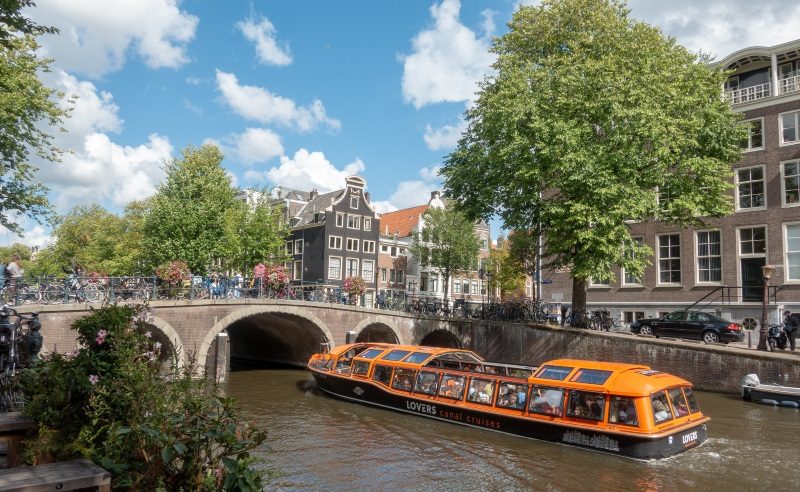Whenever you are planning to have a vacation in Western Europe, being torn between Brussels and Amsterdam is a common thing. The two cities, only 90 minutes apart by train, though somewhat comparable at first sight, offer very different experiences!
Brussels, the capital of Belgium, is a political center and an international business city being home to the UN and to NATO. Amsterdam is a young, vibrant and beautiful city and the capital to the Netherlands. Amsterdam is larger than Brussels but is slightly less populated with over 1 million inhabitants vs about 2 million for the Brussels metro area.
Table of Contents
Brussels or Amsterdam: short answer

For those in a rush, these are a few key highlights to help you decide between Brussels or Amsterdam:
- Amsterdam is a well-connected city with beautiful canals, excellent public transport, cycling lanes everywhere, cafes, and many many parks which make it a city of great character.
- Amsterdam is more of a tourist haven than Brussels. It’s lively, tolerant, entertaining, and you can see great sights in a few days. English is extensively spoken so communication won’t be so much trouble.
- Brussels is a more laid-back, easy-going European city. The architecture in the city is outstanding, shopping arcades are gorgeous, and the museums are uniquely designed, adding to the city’s flair. Brussels also has some of the best chocolate in the world.
- On the other hand, if you want a vibrant city to experience blockbuster sights, friendly and open-minded people, numerous coffee shops, and vibrant nightlife (namely thanks to the Heineken beer and legal pot-smoking), Amsterdam is your choice.
Brussels or Amsterdam: access and transportation

Brussels has two airports and the Eurostar, a direct train which takes you to central London in just about two hours. In contrast, to get to Amsterdam from London, you would need to take the Eurostar to Brussels, then a train to Amsterdam – unless of course you simply fly there. Note that Eurostar also has time-consuming passport and security checks.
While public transport in Brussels is cheaper than in Amsterdam, the canal transport system in Amsterdam is greatly appreciated by newcomers as it makes navigating the city way easier. Cycling is one of the most used methods of commuting in Amsterdam and there are plenty of bicycles readily available everywhere.
Getting from Amsterdam to Brussels by train is easy and convenient. There are two available options, the high-speed Thalys service which takes a little under 2 hours or the Intercity which takes a little under 3 hours. Both trains can be booked using the NS International site.
You can also take a 45 minutes flight between Amsterdam Schipol (AMS) and Brussels Zaventem (BRU) airport.
If you like road trips then you can go from Amsterdam to Brussels via the Euroline or Flixbus bus routes which take 3-5 hours depending on the stops and services.
Brussels or Amsterdam: vibes and people

Amsterdam feels larger than Brussels (even though it’s actually smaller). It’s a beautiful scenic city with ready-made tourist sites. Brussels is also beautiful with green parks, but it’s commonly plagued with roadwork construction and graffiti, giving it a rougher outlook – which can entice more adventurous travelers to explore the city.
The streets and building in Amsterdam have remained clean and properly kept while in Brussels sometimes displays poor maintenance and uncleanliness. In Amsterdam, the canal system and widespread cycling minimize air pollution, while in Brussels smog and traffic tend to make the air less clean.
In Amsterdam, people are friendly, energetic and enthusiastic, have a modern, hipster-like attitude, and speak English. The city has a highly energetic vibe. It is a faster-paced city than Brussels. In Brussels, people are relaxed and laid back with more of a French-type culture – some travelers feel this results in a somewhat whiny or arrogant attitude.
Amsterdam city is active with lots of tourists while Brussels has fewer tourists and a more formal atmosphere. Being home to the UN and NATO, however, Brussels has a bustling multicultural atmosphere.
Brussels has exceptional ancient medieval architecture qualifying it to be one of the most beautiful monumental cities in Europe because of its distinctive architecture. Amsterdam has a more cohesive architectural look coupled with Venice style canals.
One caveat about Amsterdam is that, due to the countless bars and coffee shops that allow the smoking of marijuana, some people feel it attracts the wrong crowd of people who come for sexual tourism and smoking weed.
Brussels or Amsterdam: sights and culture

Amsterdam is home to many popular cultural and art museums such as the Van Gogh museum, Stedelijk Museum, Madame Tussauds, and Rijksmuseum. The Ann Frank House is one of the most visited museums in the Benelux region – advance booking is advised to avoid the long queues.
There are also smaller museums such as the great FOAM and Huis Van Marseille photography museums, or the Resistance Museum. If you’re an art lover, a Sunday visit to Artplein ‘t Spui where more than 60 international artists display their work will interest you, as well as the Kunstmarkt Thorbeckepleinart market near the Rembrandtplein.
Also, you can’t go to Amsterdam and not take a canal cruise. The canals give the historical centre a striking backdrop. Most of the canal tours will take approximately an hour and you get to discover other tourist sights on board in a fun and relaxing way. You can also have a nice walk and have lunch around the Eye which overlooks the het IJ harbor-part.
The Red Light District offers a very astonishing and funky experience.
When it comes to architectural beauty, Brussels has some of the most beautiful monuments in Europe, and walking around the city allows you to discover the districts which each have their own distinctive design.
Brussels has several UNESCO world heritage sites like the Grand Place, a peaceful place to hang out and watch people, the Gothic town hall, and a few 19th-century townhouses such as Hotel Solvay and Hotel Tassel. In Amsterdam, meanwhile, the architecture of the houses offer an astonishing and attractive feel.
Brussels is the capital of Art Nouveau, with spectacular sights such as the outstanding Horta Museum, the Museum of Musical Instruments, the Maison Cyr, and whole areas such as St-Gillis and parts of Schaarbeek. The Musée Cinquantenaire museum also now has parts dedicated to Art Nouveau.

Brussels is rich in culture and art with 80 museums, including the Chocolate Museum, the Magritte Museum, as well as other unique and interesting ones such as the train museum, ADAM (Atomium, plastic design from the fifties to these days), and the very good Brussels Art Museum.
The city also boasts beautiful shopping arcades such as the Galeries Royales Saint Hubert, a Bruges-like restaurant-filled street close to the central square, and a glass ceiling pedestrian shopping area. There’s quite a lot to explore in this very walkable (plus trams) city.
Brussels also offers green parks and an intriguing Mini-Europe park which displayed miniature versions of 80 EU cities and 350 EU buildings.
Brussels or Amsterdam: food and nightlife

In Amsterdam, the nightlife is vibrant with numerous cocktail bars, brown and grand cafes, and coffee shops that allow marijuana smoking.
Most of the popular bars are found in the outskirts of the city but Rembrandtplein and Leidseplein dominate the city center nightlife with bars like Bar Oldenholf, Bar Dvar, Doka, Snappers, among many others. The cafes and bars create a social atmosphere to unwind and get an authentic Amsterdam taste and Dutch culture.
Brussels is famous for its Belgian fries and waffles, served in numerous fast-food places. It also offers some of the best chocolate in the world, found in a wide range of high-end chocolate stores.
Belgian beer is another major attraction of Brussels. You can pay a visit to the Delirium Café for more than 2000 beers from across the globe. There are numerous bars and pubs around the Grand Palace offering happy hours, open-air cocktail parties, and live music on workdays, catering to the UN, NATO, and overall business workers.
À La Mort Subite Also in the Upper Town is also a traditional café that brews its own beer.
Brussels also has many night markets to hang out at such as the Agora Roundabout craft and art market.
Brussels or Amsterdam: lodging

Amsterdam is an expensive city that can cost you up to € 150 for only a little room. Jordaan and Grachtengordel are very photogenic, super hip and awesome places to explore but they are more expensive.
The Renaissance Hotel, the NH Collection Barbizon Palace, and the IHG Crowne Plaza Hotel are great places to stay as they are within walking distance of the central station, shopping center, and tourist attractions.
Travelers also recommend the Wiechmann Hotel (on Prisengracht), around 150€ including breakfast. Family-run, close to everything, with rooms and breakfast areas with canal views, and unlimited hot drinks in the lobby. Just make sure you reserve ahead of time.
Marcel’s Creative Exchange is a hip place to stay. Marcel, the owner, is an artist who will help you define the best things to see and do based on your tastes.
In comparison to Amsterdam, Brussels is cheaper, greener, and quieter with ample choices of decent hotels and apartments to rent. The Grand Place which is close to the train station has several hotels like the Novotel and Hotel Agora, making it very convenient to stay.
NH Collection Brussels Grand Sablo (5 stars) is often described as exceptional. It’s very central and you can walk to Bruxelles-Central station, to Grand’ Place, and to Mannekin Pis. Nearby stores and restaurants can easily be walked to. Large rooms and beds, beautiful decor, nice bar, great staff.
Hotel Le Dixseptième is a centrally located boutique hotel, near the Grand’ Place. Many travelers praise this hotel and its location near Brussels Central station.
Hotel Amigo is near the Grand Place, described as a very nice hotel and location.
Hôtel des Galeries and The Dominican are well-located in the center. Hotel Odette en Ville and Hotel Hygge are in the Louise district (take the metro).
Brussels or Amsterdam: day trips
Amsterdam has a very good train network if you want to take a day trip, Options include Utrecht, 25 minutes by train, The Hague or Rotterdam, both 45 minutes by train. Zaanse Schans (20-minute train ride) or Keukenhof (40 minutes train and bus ride) also make very good day trips.
Brussels’ central situation makes it possible to access numerous places inexpensively, such as Bruges, a spectacular medieval town only 55 minutes by train, and Ghent, 40 minutes away. You can also easily take a day trip to Antwerp, Waterloo, Ypres, Leuven, Tournai, or Maastricht. See this post for an in-depth comparison of Bruges and Antwerp.
***
Photo credits:
(1) Featured: “Amsterdam” (CC BY-SA 2.0) by Kent Wang
(2) “Brussels tourist” (CC BY 2.0) by Bryn Pinzgauer
(3) “Amsterdam” (CC BY-SA 2.0) by teoruiz
(4) “Brussels” (CC BY 2.0) by hsivonen
(5) “Red-light district (De Wallen) Amsterdam” (CC BY 2.0) by Bert Kaufmann
(6) “Art nouveau architecture in Brussels” (CC BY-SA 2.0) by Vironevaeh
(7) “Brussels” (CC BY 2.0) by hsivonen
(8) “amsterdam” (CC BY 2.0) by niessbernard




